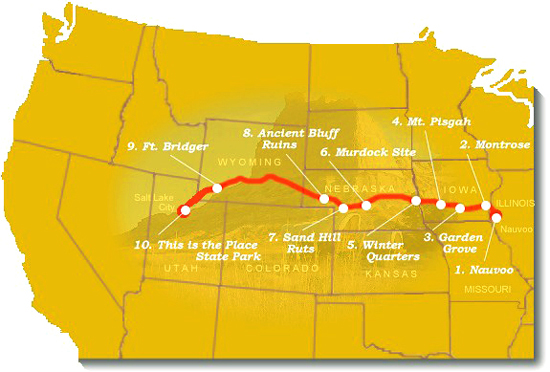Much of what Stegner wrote made me laugh (a rare occurrence when I read a history book, I assure you). For instance, in writing about one optimistic pioneer woman, Ursulia, he says that she “had a knack for making the best of things. If it had hailed stones as big as baseballs she would have come out from shelter wondering if it wasn’t a good time to make up a nice freezer of ice cream” (72). And in describing the ordeal of 20 men who stayed behind during a bleak winter to guard cached freight at Devil’s Gate, where they nearly perished from an inadequate food supply, he states, “One kind of script, at this point, calls for them to draw straws to see which should first be killed and eaten, but the Mormons, whatever their other capabilities, never showed any talent for cannibalism” (263).
 As a member of the Church of Jesus Christ of Latter Day Saints, I imagine that Stegner’s tone and views could prove to be offensive to some members, especially when he talks about Joseph Smith or Brigham Young, both of whom get slightly roasted on the spit of his acerbic wit. Yet, I think Stegner’s position as a non-Mormon enabled him to write with a perspective that at its worst distorts, but at its best allows Stegner to inject a humor and honesty into his writing that those carried away by the sincerity of their faith may not be able to do. Oftentimes, members of the church get caught up in a certain rhetoric concerning the pioneers, which reduces them to convenient object lessons, rather than complex people.
As a member of the Church of Jesus Christ of Latter Day Saints, I imagine that Stegner’s tone and views could prove to be offensive to some members, especially when he talks about Joseph Smith or Brigham Young, both of whom get slightly roasted on the spit of his acerbic wit. Yet, I think Stegner’s position as a non-Mormon enabled him to write with a perspective that at its worst distorts, but at its best allows Stegner to inject a humor and honesty into his writing that those carried away by the sincerity of their faith may not be able to do. Oftentimes, members of the church get caught up in a certain rhetoric concerning the pioneers, which reduces them to convenient object lessons, rather than complex people. Whatever his prejudices may be against the leaders of the church, Stegner does not have a hidden agenda. He states that, “I write as a non-Mormon but not a Mormon-hater. Except as it affected the actions of the people I write of, I do not deal with the Mormon faith: I do not believe it, but I do not quarrel with it either” (314).
I came away from this book with a better appreciation not just for the Mormons who traveled the hard trail west, but also for pioneers in general. There was something incalculably different about the Mormons who traveled this trail though, about these people who were willing to leave everything behind, who fled persecution, and who were asked to sacrifice so much, yet who remained faithful to their beliefs.
In a recent General Conference talk, Refuge from the Storm, Elder Patrick Kearon drew a moving parallel between the worldwide refugee crisis and the persecution of the early Church members. He said, “As members of the Church, as a people, we don’t have to look back far in our history to reflect on times when we were refugees, violently driven from homes and farms over and over again. Last weekend in speaking of refugees, Sister Linda Burton asked the women of the Church to consider, “What if their story were my story?” Their story is our story, not that many years ago.”
Kearon’s talk, as well as the recent call from the LDS church for its members to aid in the refugee crises added another dimension to my reading of this book. To reflect on the story of the Mormon trail is to reflect not just on what is past, but what is taking place in our world right now.



No comments
Post a Comment